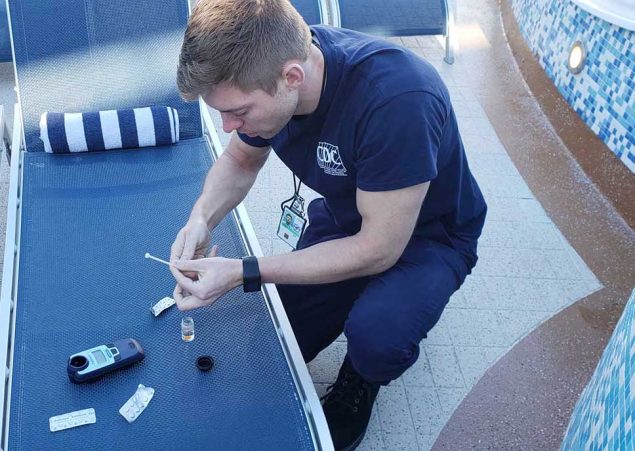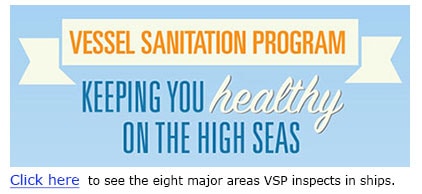Operational Inspections
Learn how and why VSP conducts operational sanitation inspections.
Why does the Vessel Sanitation Program (VSP) conduct operational sanitation inspections?
VSP inspectors conduct operational sanitation inspections to determine how well ships are operating and maintaining sanitation standards in accordance with the current VSP Operations Manual.
Inspectors provide public health guidance to cruise ship staff when standards are out of compliance.
Inspections are unannounced, and they are done while a ship is in a U.S. port.

What do VSP inspectors do during a periodic sanitation inspection?
Depending on the size of the ship, two to five inspectors examine the ship to see if it complies with the public health standards found in the current VSP Operations Manual. Inspections usually take 6-8 hours, depending on the number of inspectors, ship size, amount of time the ship is in port, and issues identified during the inspection.
| Major Areas VSP Inspects on a Ship | Inspectors Look At |
|---|---|
| Medical facilities | Documentation for gastrointestinal illness surveillance Medical logs |
| Potable water systems | Procedures from water source to storage until use Water distribution Protection and any cross-connections Disinfection process |
| Swimming pools and whirlpool spas | Filtration Disinfection General maintenance Safety |
| Galleys and dining rooms | Food protection during sourcing, provisioning, storage, preparation, and service Employee health and personal hygiene Facility equipment maintenance and dishwashing |
| Child activity centers | Properly equipped diaper changing stations, toilets, and handwashing stations Facility disinfection Infection control for ill children |
| Hotel accommodations | Routine cleaning sequences and infection control procedures during outbreaks of gastrointestinal illness, including the use of appropriate disinfectants and outbreak policies |
| Ventilation systems | System maintenance System cleaning |
| Common areas of the ship | Integrated pest management strategies General cleanliness Maintenance |
At the end of each inspection, VSP inspectors meet with ship management to discuss inspection violations and give them a draft inspection report. Within 2 weeks of the inspection, VSP sends a final copy of the inspection report to the ship’s cruise line.
How often are ships inspected?
Cruise ships under VSP’s jurisdiction are subject to two inspections each year. If a ship sails outside of the United States for an extended period, it may not be inspected twice a year, but it will be inspected again when it returns to the United States.
Do ships know when the inspection will occur?
No. The twice-yearly inspections are unannounced.
How are cruise ships scored?
Cruise ships are scored on a 100-point scale. Inspection criteria are defined in the current VSP Operations Manual. Criteria are assigned a point value; points are deducted from the score when there is a pattern of similar violations of the same criteria or when there is a single, significant violation.
Points are deducted from that score based on public health significance. An 85 or below is a failing score. All scores are posted on the VSP website.
Are ships required to correct violations found during inspections?
Yes. Although ships are responsible for correcting all violations, some critical violations must be corrected immediately. Each ship submits a corrective action statement describing how the violations were corrected.
Some violations can be corrected during the inspection; others may take longer to correct.
What happens if a ship fails an inspection?
Ships that fail inspections are reinspected within a reasonable time period.
When would VSP recommend that a ship not sail?
An inspection failure does not warrant a no-sail recommendation unless there is an imminent public health risk.
VSP may recommend that the ship not sail if there are imminent public health risks including the following:
- Inability to properly chlorinate potable (drinking) water.
- Inability to keep food within safe temperatures.
- Inadequate facilities for cleaning and sanitizing food equipment.
- Inability to properly dispose of solid or liquid waste.
VSP may also recommend a ship not sail during an infectious disease outbreak where continuing normal operations may subject newly arriving passengers to disease.
If a cruise line refuses to follow a VSP no-sail recommendation, it can become a no-sail order.
Where can I find inspection scores and reports?
Inspection reports and scores as well as corrective action statements are available on the VSP website.
How much do inspections cost?
Cruise ship owners pay a fee based on the ship’s size for operational inspections and reinspections.
Fees
Fee Schedule, January 1, 2023-September 30, 2023
| Vessel Size (GRT1) | Inspection Fee |
|---|---|
| Extra Small (<3,000 GRT) | US$1,495 |
| Small (3,001-15,000 GRT) | US$2,990 |
| Medium (15,001-30,000 GRT) | US$5,980 |
| Large (30,001-60,000 GRT) | US$8,970 |
| Extra Large (60,001-120,000 GRT) | US$11,960 |
| Mega (>120,001-140,000 GRT) | US$17,940 |
| Super Mega (>140,001 GRT) | US$23,920 |
1Gross register tonnage in cubic feet, as shown in Lloyd’s Register of Shipping.
The fee schedule is also posted in the Federal Register.
